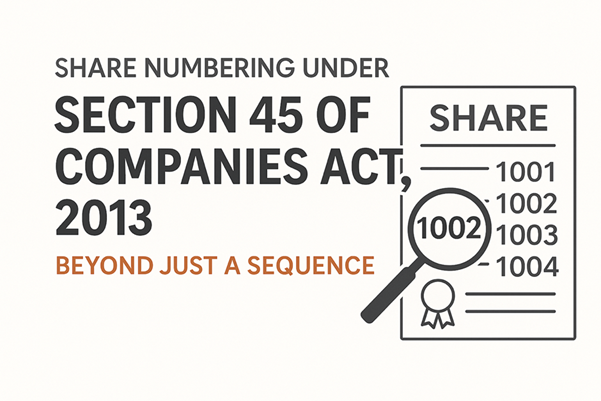When we think of a company’s shares, it’s easy to view them as simple units of ownership. But beneath this simplicity lies a critical mechanism that ensures clarity, traceability, and transparency—share numbering. As per Section 45 of the Companies Act, 2013, every share in a company with share capital must be identified by a distinctive number. But what does this really mean, and why does it matter?
Let’s dive into the nuances of Section 45 and discover how a seemingly mundane detail like numbering shares plays a pivotal role in corporate governance and finance.

Key Pointers:
Unique Identification: Every share in a company with share capital must have a distinctive number, enabling accurate identification, ownership tracking, and preventing duplication or fraud.
- Legal Exemption: The rule does not apply to shares held in a depository system, where beneficiary ownership is recorded electronically.
- Transparency & Compliance: Numbering enhances transparency, aids in auditing, and ensures regulatory compliance, particularly in share transfers and shareholder disputes.
- Operational Benefits: Numbering supports record maintenance, simplifies transactions, and prevents counterfeiting, especially in public companies.
- Complexities in Numbering: Companies may adopt sequential or non-sequential numbering systems depending on the share class, bonus issues, or mergers, requiring careful planning and integration.
Share Numbering: Beyond Just a Sequence
Why do shares need numbers? Are they just random digits or do they serve a higher purpose?
In reality, each share’s unique number acts like a fingerprint—critical for tracking ownership, settling disputes, enabling transparency, and facilitating seamless share transfers. It’s more than just a sequence—it’s a safeguard.
Simplifying Section 45 of the Companies Act, 2013
Section 45 clearly mandates:
“Every share in a company having a share capital shall be distinguished by its distinctive number.”
Exception: This rule doesn’t apply to shares held in dematerialized (demat) form by beneficiaries whose names are recorded in a depository system.
Key Components Explained
- Shares:
Shares represent a unit of ownership in a company. There are various classes of shares—such as equity shares and preference shares—each conferring different rights and privileges to the holder.
- Share Capital:
Share capital forms the financial foundation of a company, reflecting both ownership and the extent of investment. It is essential for both investors and companies to understand the various categories of share capital and the regulatory framework applicable to them.
- Holder of Beneficial Interest:
In line with Section 89 of the Companies Act, 2013 and the interpretation by the Centre for Corporate Governance Research and Training (ICSI-CCGRT), a holder of beneficial interest is a person who enjoys the benefits of ownership, although the legal title may be held by someone else. This concept often arises in trust relationships, where the beneficial owner has a right to the benefits derived from the shares, despite not being the registered owner.
- Records of Depository:
A depository refers to an entity—such as an institution or infrastructure—that facilitates the safekeeping and transfer of securities in electronic form. According to the rules under Chapter 24 related to depositories, a “record of depositors” refers to the official document or data maintained by the depository and provided to a listed company, detailing the names of beneficial shareholders and their holdings.
Important Advantages of Numbering Shares
- Tracking Ownership: Identifies exact ownership—essential for voting, dividends, and audits.
- Facilitating Transfers: Smooth transfer process, reducing risks of duplicate ownership or fraud.
- Combating Counterfeiting: A unique number makes it nearly impossible to forge share certificates.
- Enhancing Transparency: Ensures clarity for investors and regulators through clear documentation.
Numbers with Nuances
Though the concept appears simple, implementation brings layers of complexity:
- Sequential vs. Non-Sequential Numbering: While most companies assign numbers in sequence, some prefer non-sequential formats for special issuance like bonus shares.
- Multiple Share Classes: Companies might adopt different numbering formats for equity, preference, or other special categories.
- Mergers & Acquisitions: Integration of share registries during corporate restructuring requires careful planning and numbering system adjustments.
Legal Implications of Share Numbering
- Regulatory Compliance & Auditing: Distinctive numbers simplify audits and compliance checks.
- Resolving Disputes: In cases of conflicting ownership claims, share numbers offer legal clarity.
- Litigation & Investigations: Vital for identifying irregularities during forensic audits or legal probes.
Maintaining Records under Section 45
The balance sheet of a corporation is an accounting document that lists its assets, liabilities, and shareholder equity as of a certain date.
- Assets: – The items of the company that can be converted into cash are known as assets of the company. They are of two types:
- Current Assets
- Long term Assets
- Liabilities: – The liabilities refer to the amount of money that are borrowed by the corporation as loans and expenses. They are of two types:
- Current liabilities
- Non-current liabilities
The balance sheet of the company contains enormous valuable information. The following are the contents of the balance sheet: –
- Information on assets like goodwill.
- Inventories
- Intangibles,
- Accounts receivable,
- P&E (property, plant & equipment)
- Liabilities like tax information, accounts payable, financing, etc.
Conclusion: Beyond the Basics
On the surface, numbering shares may appear as a bureaucratic formality. But in reality, it’s the backbone of a company’s internal structure and external transparency. From preventing fraud to streamlining investor relations, this system brings immense value.
Section 45 isn’t just a legal requirement—it’s a strategic tool in the governance arsenal.
FAQs
Q1. What is an example of share numbering?
A company with 5,000 shares will assign numbers from 1 to 5,000, each uniquely identifying a share and its holder.
Q2. Are share certificates required to be numbered?
Yes, every certificate carries a unique number to distinguish it from others.
Q3. What is a basic number of shares?
It refers to the number of shares currently available in the secondary market.
Q4. What law governs share numbering?
Section 45 of the Companies Act, 2013.
Q5. What is the number of issued shares?
It is recorded in the company’s balance sheet and represents shares sold to investors.
Q6. Who decides the number of shares in a company?
At incorporation, the company fixes this number, and any changes require shareholder approval.
Q7. Can the number of shares increase automatically?
No. Any increase must be approved by shareholders.
Q8. Formula for calculating outstanding shares?
Outstanding shares = Issued shares – Treasury shares
Q9. Stock vs. Share—what’s the difference?
Stock is a broad ownership in multiple companies. A share is ownership in a single company.
Q10. What is a unique share certificate number?
Each certificate has a distinct number, making every share traceable and unique.
